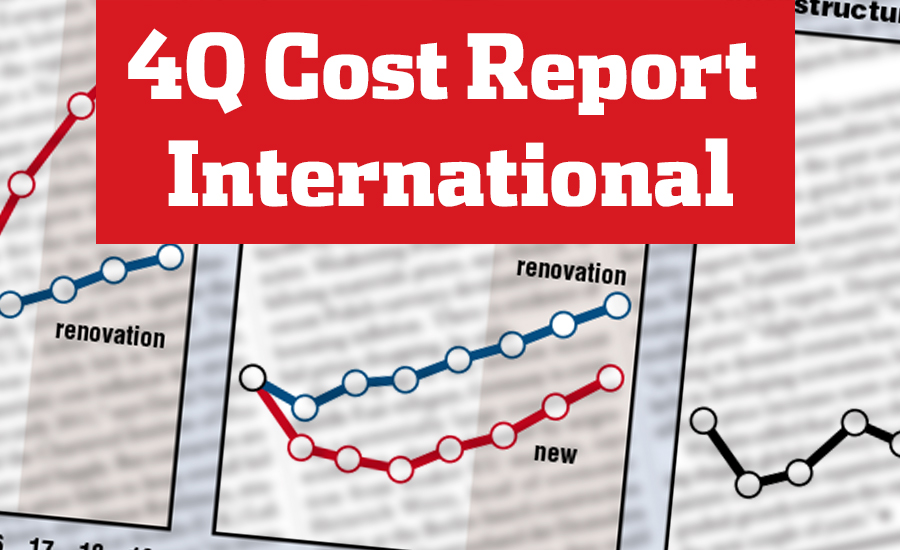The U.K.’s Brexit vote last June, which called for it to exit membership in the European Union, is among factors that lowered midterm expectations for the region’s construction market, says a November report from the Euroconstruct forecasters from 19 European countries. The 2016 growth forecast fell 0.6%, to 2%, with only marginal hikes through 2020. Eastern Europe will grow the fastest, up 5.3% a year for the next three years, compared to 2% in the West.
|
Click Here to View the 4Q Cost Report PDF |
Brexit caused U.K. currency devaluation of nearly 10% and 15% against the euro and U.S. dollar, respectively. The impact “was widely felt in November, with [materials] cost inflation the strongest since early 2011,” says David Noble, CEO of the Chartered Institute of Procurement and Supply. But contractors are absorbing price hikes to keep overall bid levels down, says Simon Rawlinson, strategic research head at Arcadis (U.K.) Ltd.
But the weaker currency is “an incentive for foreign investment,” notes Miguel Jurado, chairman of Spain’s FCC Construcción S.A. After a post-referendum dip, demand “bounced back,” boosted by government backing of major infrastructure, he says. In that resilient sector, “we expect prices to continue to grow [at about 3%],” says Will Waller, Arcadis market intelligence lead. But Brexit uncertainty is depressing the commercial sector, where he expects bid prices to fall.
Next March, as U.K. Prime Minister Theresa May plans to begin two years of Brexit talks with the 27 remaining EU member nations, the fate of continental workers in Britain’s underresourced construction sector is a concern. After Brexit, the U.K. will no longer have to allow EU workers unrestrained entry. They make up 10% of the overall labor force, with 50% in London, says Waller. “Missing out on over 200,000 people entering the workforce could mean rising costs,” adds James Bryce, Arcadis workforce planning director. But Waller says the data do not support pro-Brexit claims that migrant labor depressed U.K. pay rates.
Since many U.K. migrants are Polish, Brexit caused “complete shock” in Poland, says Jan Holyst, partner in Warsaw cost consultant Sentient SP z.o.o.. He is uncertain if Polish crews in the U.K. can remain, but there also are more layoffs by major contractors at home, he notes. Weakening Polish demand is stabilizing materials prices, says Holyst. A recent Polish currency devaluation is not boosting inflation. There is evidence of bid prices dropping, he adds.
Hosting up to one million recent Middle East refugees, Germany is creating a potentially large construction workforce, already boosted by migration from weaker EU markets, says Heinrich Weitz, head of economic policy at the Berlin-based construction association Hauptverband der Deutschen Bauindustrie. With training, they could take, in two to three years, unfilled industry jobs, he adds. Germany’s workforce now is 13.2% foreign, up from 7.6% in 2008, says Weitz. The flexible labor market and better productivity are “keeping prices down,” he notes. German construction spending is buoyant, yet sector inflation is only about 1.5%. Initial fears are dissipating that Brexit would hurt Germany’s economy. Weitz foresees a possible Brexit bonus as investors divert planned projects from the U.K. to that nation.
Looking globally, “prices for construction-related non-fuel commodities have trended downward for the past several years. Generally, this is good for manufacturing economies and bad for commodity export-based economies,” said Tom Wiggins, Faithful + Gould lead value manager in a July report. Despite commodity prices’ “slight rebound,” he noted, “as long as demand remains low, particularly in developing economies, broad significant price increases seem unlikely.”
Wiggins added that “since the continuing sluggish global recovery does not fit the pattern of previous expansions, a slow and gradual growth remains the expectation for the next couple of years.”







Post a comment to this article
Report Abusive Comment